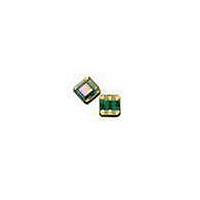APDS-9008-020 Avago Technologies US Inc., APDS-9008-020 Datasheet - Page 9

APDS-9008-020
Manufacturer Part Number
APDS-9008-020
Description
IC PHOTOSENSOR AMBIENT 6CHIPLED
Manufacturer
Avago Technologies US Inc.
Type
Ambient Light Photo Sensorr
Specifications of APDS-9008-020
Package / Case
6-ChipLED - 1.60mm L x 1.50mm W x 0.55mm H
Wavelength
565nm
Output Type
Analog
Peak Wavelength
565 nm
Maximum Light Current
52 uA
Maximum Dark Current
300 nA
Maximum Rise Time
5 ms
Maximum Fall Time
5 ms
Maximum Operating Temperature
+ 85 C
Mounting Style
SMD/SMT
Product
Ambient Light Sensor
Output Current
40µA
Sensor Output
Analog
Supply Voltage Range Dc
1.6V To 5.5V
Length/height, External
0.55mm
Peak Reflow Compatible (260 C)
Yes
External Width
1.6mm
Rise Time
5ms
Rohs Compliant
Yes
External Depth
1.5mm
Leaded Process Compatible
Yes
Lead Free Status / RoHS Status
Lead free / RoHS Compliant
Lead Free Status / RoHS Status
Lead free / RoHS Compliant, Lead free / RoHS Compliant
Available stocks
Company
Part Number
Manufacturer
Quantity
Price
Company:
Part Number:
APDS-9008-020
Manufacturer:
SILICON
Quantity:
9 200
Part Number:
APDS-9008-020
Manufacturer:
AVAGO/安华高
Quantity:
20 000
Recommended Reflow Profile
The reflow profile is a straight-line representation of a
nominal temperature profile for a convective reflow sol-
der process. The temperature profile is divided into four
process zones, each with different ΔT/Δtime temperature
change rates or duration. The ΔT/Δtime rates or duration
are detailed in the above table. The temperatures are
measured at the component to printed circuit board con-
nections.
Process zone P1
heated to a temperature of 150°C to activate the flux in
the solder paste. The temperature ramp up rate, R1, is lim-
ited to 3°C per second to allow for even heating of both
the PC board and component pins.
Process zone P2
to 180 seconds) to dry the solder paste. The temperature
is raised to a level just below the liquidus point of the sol-
der.
Process zone P3
temperature is quickly raised above the liquidus point of
9
150
120
255
230
217
200
180
80
25
Process Zone
Heat Up
Solder Paste Dry
Solder Reflow
Cool Down
Time maintained above liquidus point , 217°C
Peak Temperature
Time within 5°C of actual Peak Temperature
Time 25°C to Peak Temperature
0
, the PC board and component pins are
should be of sufficient time duration (100
R1
is the solder reflow zone. In zone P3, the
HEAT
UP
P1
50
R2
Symbol
P1, R1
P2, R2
P3, R3
P3, R4
P4, R5
SOLDER PASTE DRY
100
P2
150
ΔT
25°C to 150°C
150°C to 200°C
200°C to 260°C
260°C to 200°C
200°C to 25°C
> 217°C
260°C
>255°C
25°C to 260°C
solder to 260°C (500°F) for optimum results. The dwell time
above the liquidus point of solder should be between 60
and 120 seconds. This is to assure proper coalescing of the
solder paste into liquid solder and the formation of good
solder connections. Beyond the recommended dwell time
the intermetallic growth within the solder connections
becomes excessive, resulting in the formation of weak
and unreliable connections. The temperature is then rap-
idly reduced to a point below the solidus temperature of
the solder to allow the solder within the connections to
freeze solid.
Process zone P4
cool down rate, R5, from the liquidus point of the solder
to 25°C (77°F) should not exceed 6°C per second maxi-
mum. This limitation is necessary to allow the PC board
and component pins to change dimensions evenly, put-
ting minimal stresses on the component.
It is recommended to perform reflow soldering no more
than twice.
R3
60 sec to 90 sec
Above 217°C
MAX 260°C
200
REFLOW
SOLDER
P3
R4
is the cool down after solder freeze. The
Maximum ΔT/Δtime or
Duration
3°C/s
100s to 180s
3°C/s
-6°C/s
-6°C/s
60s to 120s
-
20s to 40s
8mins
COOL DOWN
250
P4
R5
300
(SECONDS)
t-TIME

























